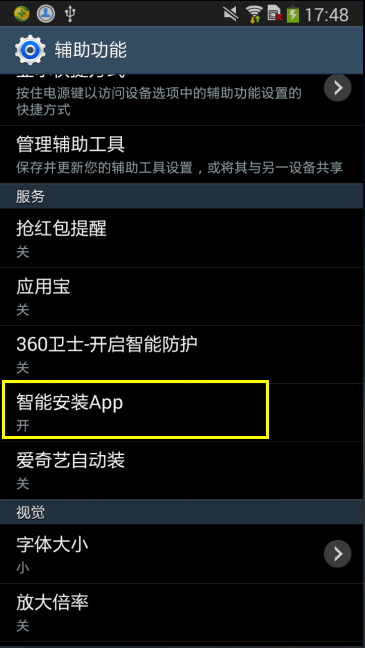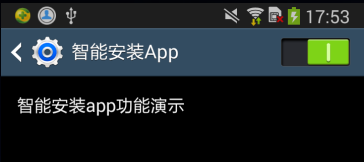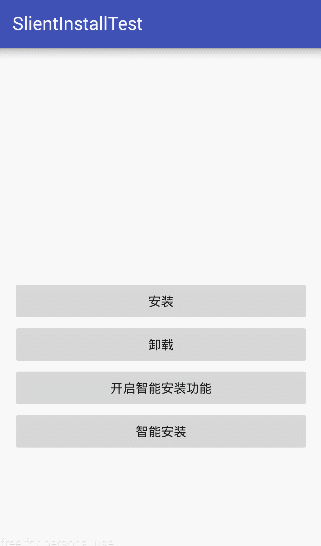Android 静默安装和智能安装的实现方法
1 简介
最近研究了Android的静默安装和智能安装,于是写博客记录一下。静默安装就是无声无息的在后台安装apk,没有任何界面提示。智能安装就是有安装界面,但全部是自动的,不需要用户去点击。
首先强调两点:静默安装必须要root权限 智能安装必须要用户手动开启无障碍服务
2 原理
静默安装、卸载的原理就是利用pm install命令来安装apk,pm uninstall 来卸载apk. 智能安装是利用android系统提供的无障碍服务AccessibilityService,来模拟用户点击,从而自动安装.
3 pm命令介绍
(1) pm install
pm install 命令的用法及参数解释如下:
<code class="hljs haml">pm install [-l] [-r] [-t] [-i INSTALLER_PACKAGE_NAME] [-s] [-f] PATH Options: -l: install the package with FORWARD_LOCK. -r: reinstall an exisiting app, keeping its data. -t: allow test .apks to be installed. -i: specify the installer package name. -s: install package on sdcard. -f: install package on internal flash.</code>
(2) pm uninstall
pm uninstall 命令的用法及参数解释如下:
<code class="hljs livecodeserver">pm uninstall [-k] PACKAGE Options: -k: keep the data and cache directories around.</code>
上面英语很简单,不解释了.
4 静默安装
为了方便演示,我把爱奇艺的安装包重命名为test.apk后放在了sdcard上。你可以自己去爱奇艺官网去下载,也可以自己找一个apk放到sdcard上,但是要知道apk的包名,后面卸载的时候要用到。
先上代码:
<code class="hljs cs">//静默安装
private void installSlient() {
String cmd = "pm install -r /mnt/sdcard/test.apk";
Process process = null;
DataOutputStream os = null;
BufferedReader successResult = null;
BufferedReader errorResult = null;
StringBuilder successMsg = null;
StringBuilder errorMsg = null;
try {
//静默安装需要root权限
process = Runtime.getRuntime().exec("su");
os = new DataOutputStream(process.getOutputStream());
os.write(cmd.getBytes());
os.writeBytes("\n");
os.writeBytes("exit\n");
os.flush();
//执行命令
process.waitFor();
//获取返回结果
successMsg = new StringBuilder();
errorMsg = new StringBuilder();
successResult = new BufferedReader(new InputStreamReader(process.getInputStream()));
errorResult = new BufferedReader(new InputStreamReader(process.getErrorStream()));
String s;
while ((s = successResult.readLine()) != null) {
successMsg.append(s);
}
while ((s = errorResult.readLine()) != null) {
errorMsg.append(s);
}
} catch (Exception e) {
e.printStackTrace();
} finally {
try {
if (os != null) {
os.close();
}
if (process != null) {
process.destroy();
}
if (successResult != null) {
successResult.close();
}
if (errorResult != null) {
errorResult.close();
}
} catch (Exception e) {
e.printStackTrace();
}
}
//显示结果
tvTest.setText("成功消息:" + successMsg.toString() + "\n" + "错误消息: " + errorMsg.toString());
}</code>
这段代码就是在程序中执行pm命令,和在adb下执行 pm install -r /mnt/sdcard/test.apk 效果是一样的, 关键的代码是 Runtime.getRuntime().exec(“su”) ,这段代码会要求获取root权限,所以你的手机必须root,不想root的话,直接用模拟器也可以。
通过 Runtime.getRuntime().exec(“su”) 获取到 process 对象后就可以写入命令了,每写入一条命令就要换行,写入 ‘\n' 即可,最后写入exit后离开命令执行的环境.
5 静默卸载
静默卸载和静默安装是一样的,只是命令不同,静默卸载需要用到包名,同样,静默卸载也需要root权限
看代码:
<code class="hljs java">//爱奇艺apk的包名
private static final String PACKAGE_NAME = "com.qiyi.video";
//静默卸载
private void uninstallSlient() {
String cmd = "pm uninstall " + PACKAGE_NAME;
Process process = null;
DataOutputStream os = null;
BufferedReader successResult = null;
BufferedReader errorResult = null;
StringBuilder successMsg = null;
StringBuilder errorMsg = null;
try {
//卸载也需要root权限
process = Runtime.getRuntime().exec("su");
os = new DataOutputStream(process.getOutputStream());
os.write(cmd.getBytes());
os.writeBytes("\n");
os.writeBytes("exit\n");
os.flush();
//执行命令
process.waitFor();
//获取返回结果
successMsg = new StringBuilder();
errorMsg = new StringBuilder();
successResult = new BufferedReader(new InputStreamReader(process.getInputStream()));
errorResult = new BufferedReader(new InputStreamReader(process.getErrorStream()));
String s;
while ((s = successResult.readLine()) != null) {
successMsg.append(s);
}
while ((s = errorResult.readLine()) != null) {
errorMsg.append(s);
}
} catch (Exception e) {
e.printStackTrace();
} finally {
try {
if (os != null) {
os.close();
}
if (process != null) {
process.destroy();
}
if (successResult != null) {
successResult.close();
}
if (errorResult != null) {
errorResult.close();
}
} catch (Exception e) {
e.printStackTrace();
}
}
//显示结果
tvTest.setText("成功消息:" + successMsg.toString() + "\n" + "错误消息: " + errorMsg.toString());
}</code>
和静默安装一样的代码就不解释了。还有,如果你不知道一个apk的包名,那么请反编译后去看AndroidManifest.xml文件,如果这个文件打开全是乱码,说明是被混淆过的,那么直接安装它,然后到/data/data下面去找它的包,当然,手机得root才能进/data/data目录。
6 智能安装
智能安装就稍微麻烦点了,原理是用到了android提供的AccessibilityService服务,这个服务可以获取屏幕上的节点,一个节点也就是一个view,我们写的xml文件中每个标签就是一个节点,然后可以模拟用户的操作,对这些节点进行点击、滑动等操作。我们就是利用这个原理,来自动点击安装按钮的,当然使用这个服务必须用户手动开启无障碍服务。下面我们来看具体的实现方法。
(1) 创建AccessibilityService配置文件
在res目录下创建xml目录,然后在xml目录下创建一个accessibility_service_config.xml文件,内容如下
res/xml/accessibility_service_config.xml:
<code class="hljs xml" data-filtered="filtered"></accessibility-service></code>
accessibilityEventTypes:指定我们在监听窗口中可以模拟哪些事件,typeAllMask表示所有的事件都能模拟.
accessibilityFeedbackType:指定无障碍服务的反馈方式.
canRetrieveWindowContent:指定是否允许我们的程序读取窗口中的节点和内容,当然是true.
description: 当用户手动配置服务时,会显示给用户看.
packageNames: 指定我们要监听哪个应用程序下的窗口活动,这里写com.android.packageinstaller表示监听Android系统的安装界面。
其余参数照写即可。
res/strings.xml:
<code class="hljs xml"><resources> <string name="app_name">SlientInstallTest</string> <string name="desc">智能安装app功能演示</string> </resources></code>
(2) 创建AccessibilityService服务
<code class="hljs java">public class MyAccessibilityService extends AccessibilityService {
private static final String TAG = "[TAG]";
private Map<integer, boolean=""> handleMap = new HashMap<>();
@Override
public void onAccessibilityEvent(AccessibilityEvent event) {
AccessibilityNodeInfo nodeInfo = event.getSource();
if (nodeInfo != null) {
int eventType = event.getEventType();
if (eventType == AccessibilityEvent.TYPE_WINDOW_CONTENT_CHANGED || eventType == AccessibilityEvent.TYPE_WINDOW_STATE_CHANGED) {
if (handleMap.get(event.getWindowId()) == null) {
boolean handled = iterateNodesAndHandle(nodeInfo);
if (handled) {
handleMap.put(event.getWindowId(), true);
}
}
}
}
}
@Override
public void onInterrupt() {
}
//遍历节点,模拟点击安装按钮
private boolean iterateNodesAndHandle(AccessibilityNodeInfo nodeInfo) {
if (nodeInfo != null) {
int childCount = nodeInfo.getChildCount();
if ("android.widget.Button".equals(nodeInfo.getClassName())) {
String nodeCotent = nodeInfo.getText().toString();
Log.d(TAG, "content is: " + nodeCotent);
if ("安装".equals(nodeCotent) || "完成".equals(nodeCotent) || "确定".equals(nodeCotent)) {
nodeInfo.performAction(AccessibilityNodeInfo.ACTION_CLICK);
return true;
}
}
//遇到ScrollView的时候模拟滑动一下
else if ("android.widget.ScrollView".equals(nodeInfo.getClassName())) {
nodeInfo.performAction(AccessibilityNodeInfo.ACTION_SCROLL_FORWARD);
}
for (int i = 0; i < childCount; i++) {
AccessibilityNodeInfo childNodeInfo = nodeInfo.getChild(i);
if (iterateNodesAndHandle(childNodeInfo)) {
return true;
}
}
}
return false;
}
}</integer,></code>
当进入apk安装界面就会回调onAccessibilityEvent()这个方法,我们只关心TYPE_WINDOW_CONTENT_CHANGED和TYPE_WINDOW_STATE_CHANGED两个事件,为了防止重复处理事件,用一个map来过滤事件,后面递归遍历节点,找到'安装' ‘完成' ‘确定' 的按钮,就点击,由于安装界面需要滚动一下才能出现安装按钮,所以遇到ScrollView的时候就滚动一下.
(3) 在AndroidManifest中配置服务
<code class="hljs xml"><uses-permission android:name="android.permission.READ_EXTERNAL_STORAGE"> <intent-filter> <category android:name="android.intent.category.LAUNCHER"> </category></action></intent-filter> </activity> <service android:label="智能安装App" android:name=".MyAccessibilityService" android:permission="android.permission.BIND_ACCESSIBILITY_SERVICE"> <intent-filter> </action></intent-filter> <meta-data android:name="android.accessibilityservice" android:resource="@xml/accessibility_service_config"> </meta-data></service> </application></uses-permission></code>
重点是后面的service标签:
android:label:这个就是用户看到的无障碍服务的名称
android:permission: 需要用到BIND_ACCESSIBILITY_SERVICE这个权限.
action: android.accessibilityservice.AccessibilityService 有了这个action,用户才能在设置里面看到我们的服务,否则用户无法开启我们写的服务,也就不能进到我们写的MyAccessibilityService里面了.所以,注意不要写错了,如果你发现无障碍服务里面没有我们写的服务,请检查这里.
(4) 调用智能安装代码
前面准备工作完毕后,现在要用了,调用智能安装的代码如下:
<code class="hljs cs"> //智能安装
private void smartInstall() {
Uri uri = Uri.fromFile(new File("/mnt/sdcard/test.apk"));
Intent localIntent = new Intent(Intent.ACTION_VIEW);
localIntent.setDataAndType(uri, "application/vnd.android.package-archive");
startActivity(localIntent);
}</code>
(5) 手动配置智能安装服务
代码运行之后,还要用户选择开启智能安装服务,让用户自己去找是不明智的,因此,我们要主动跳到配置界面,代码如下:
<code class="hljs cs">//跳转到开启智能安装服务的界面 Intent intent = new Intent(Settings.ACTION_ACCESSIBILITY_SETTINGS); startActivity(intent);</code>
配置如下图:

看到了吗,上面显示的就是Service里面的label的值,如果你没有上面的选项,请检查AndroidManifest里面Service的配置.
点击'智能安装App',开启服务,如下图:

其中的提示文字就是我们在res/xml/accessibility_service_config.xml文件中配置的description属性
7 只能我们写的app可以自动安装
这样写完代码可以运行,点击按钮自动安装sdcard上的test.apk.但是你会发现,所有apk都会自动安装,这就不符合我们的要求了,我们要求只能通过我们写的app来自动安装,其他apk还是要用户手动去点。怎么解决这个问题呢?
思路是:在MainActivity中创建一个public static boolean flag,在MyAccessibilityService的onAccessibilityEvent()中加一个flag判断,然后调用智能安装前flag设为true,创建apk安装事件的广播接收器,当apk安装完成后,设置falg为false,这样其他apk就不能自动安装了,就解决了这个问题
下面上完整代码.
8 完整代码
app/MainActivity.java:
<code class="hljs java">public class MainActivity extends AppCompatActivity implements View.OnClickListener {
private static final String TAG = "[TAG][MainActivity]";
private static final String PACKAGE_NAME = "com.qiyi.video";
private String apkPath = "/mnt/sdcard/test.apk";
public static boolean flag = false;//控制只能自己的app才能执行智能安装
private TextView tvTest;
private MyInstallReceiver receiver;
@Override
protected void onCreate(Bundle savedInstanceState) {
super.onCreate(savedInstanceState);
setContentView(R.layout.activity_main);
tvTest = (TextView) findViewById(R.id.tv_test);
findViewById(R.id.btn_install).setOnClickListener(this);
findViewById(R.id.btn_uninstall).setOnClickListener(this);
findViewById(R.id.btn_set).setOnClickListener(this);
findViewById(R.id.btn_smart_install).setOnClickListener(this);
//注册apk安装监听
receiver = new MyInstallReceiver();
IntentFilter filter = new IntentFilter();
filter.addAction("android.intent.action.PACKAGE_ADDED");
filter.addAction("android.intent.action.PACKAGE_REMOVED");
filter.addDataScheme("package");
this.registerReceiver(receiver, filter);
}
@Override
public void onClick(View v) {
switch (v.getId()) {
//静默安装
case R.id.btn_install:
installSlient();
break;
//静默卸载
case R.id.btn_uninstall:
uninstallSlient();
break;
//设置无障碍服务
case R.id.btn_set:
//跳转到开启无障碍服务的界面
Intent intent = new Intent(Settings.ACTION_ACCESSIBILITY_SETTINGS);
startActivity(intent);
break;
//智能安装
case R.id.btn_smart_install:
//控制只能自己的app才能智能安装
flag = true;
smartInstall();
break;
}
}
//静默安装
private void installSlient() {
String cmd = "pm install -r /mnt/sdcard/test.apk";
Process process = null;
DataOutputStream os = null;
BufferedReader successResult = null;
BufferedReader errorResult = null;
StringBuilder successMsg = null;
StringBuilder errorMsg = null;
try {
//静默安装需要root权限
process = Runtime.getRuntime().exec("su");
os = new DataOutputStream(process.getOutputStream());
os.write(cmd.getBytes());
os.writeBytes("\n");
os.writeBytes("exit\n");
os.flush();
//执行命令
process.waitFor();
//获取返回结果
successMsg = new StringBuilder();
errorMsg = new StringBuilder();
successResult = new BufferedReader(new InputStreamReader(process.getInputStream()));
errorResult = new BufferedReader(new InputStreamReader(process.getErrorStream()));
String s;
while ((s = successResult.readLine()) != null) {
successMsg.append(s);
}
while ((s = errorResult.readLine()) != null) {
errorMsg.append(s);
}
} catch (Exception e) {
e.printStackTrace();
} finally {
try {
if (os != null) {
os.close();
}
if (process != null) {
process.destroy();
}
if (successResult != null) {
successResult.close();
}
if (errorResult != null) {
errorResult.close();
}
} catch (Exception e) {
e.printStackTrace();
}
}
//显示结果
tvTest.setText("成功消息:" + successMsg.toString() + "\n" + "错误消息: " + errorMsg.toString());
}
//静默卸载
private void uninstallSlient() {
String cmd = "pm uninstall " + PACKAGE_NAME;
Process process = null;
DataOutputStream os = null;
BufferedReader successResult = null;
BufferedReader errorResult = null;
StringBuilder successMsg = null;
StringBuilder errorMsg = null;
try {
//卸载也需要root权限
process = Runtime.getRuntime().exec("su");
os = new DataOutputStream(process.getOutputStream());
os.write(cmd.getBytes());
os.writeBytes("\n");
os.writeBytes("exit\n");
os.flush();
//执行命令
process.waitFor();
//获取返回结果
successMsg = new StringBuilder();
errorMsg = new StringBuilder();
successResult = new BufferedReader(new InputStreamReader(process.getInputStream()));
errorResult = new BufferedReader(new InputStreamReader(process.getErrorStream()));
String s;
while ((s = successResult.readLine()) != null) {
successMsg.append(s);
}
while ((s = errorResult.readLine()) != null) {
errorMsg.append(s);
}
} catch (Exception e) {
e.printStackTrace();
} finally {
try {
if (os != null) {
os.close();
}
if (process != null) {
process.destroy();
}
if (successResult != null) {
successResult.close();
}
if (errorResult != null) {
errorResult.close();
}
} catch (Exception e) {
e.printStackTrace();
}
}
//显示结果
tvTest.setText("成功消息:" + successMsg.toString() + "\n" + "错误消息: " + errorMsg.toString());
}
//智能安装
private void smartInstall() {
Uri uri = Uri.fromFile(new File(apkPath));
Intent localIntent = new Intent(Intent.ACTION_VIEW);
localIntent.setDataAndType(uri, "application/vnd.android.package-archive");
startActivity(localIntent);
}
//监听apk安装
private class MyInstallReceiver extends BroadcastReceiver {
@Override
public void onReceive(Context context, Intent intent) {
if (intent.getAction().equals("android.intent.action.PACKAGE_ADDED")) { // install
String packageName = intent.getDataString();
Log.i(TAG, "安装了 :" + packageName);
//安装完毕,设置flag,从而使得其余的apk不能自动安装
flag = false;
}
if (intent.getAction().equals("android.intent.action.PACKAGE_REMOVED")) { // uninstall
String packageName = intent.getDataString();
Log.i(TAG, "卸载了 :" + packageName);
}
}
}
@Override
protected void onDestroy() {
super.onDestroy();
if (receiver != null) {
unregisterReceiver(receiver);
}
}
}</code>
界面上就三个按钮
res/layout/activity_main.xml:
<code class="hljs xml"><!--?xml version="1.0" encoding="utf-8"?--> <relativelayout android:layout_height="match_parent" android:layout_width="match_parent" android:paddingbottom="@dimen/activity_vertical_margin" android:paddingleft="@dimen/activity_horizontal_margin" android:paddingright="@dimen/activity_horizontal_margin" android:paddingtop="@dimen/activity_vertical_margin" xmlns:android="https://schemas.android.com/apk/res/android" xmlns:tools="https://schemas.android.com/tools"> <textview android:id="@+id/tv_test" android:layout_height="wrap_content" android:layout_width="match_parent" android:text=""><button android:id="@+id/btn_install" android:layout_centerinparent="true" android:layout_height="wrap_content" android:layout_width="match_parent" android:text="安装"></button><button android:id="@+id/btn_uninstall" android:layout_below="@id/btn_install" android:layout_height="wrap_content" android:layout_width="match_parent" android:text="卸载"></button><button android:id="@+id/btn_set" android:layout_below="@id/btn_uninstall" android:layout_height="wrap_content" android:layout_width="match_parent" android:text="开启智能安装功能"></button></textview></relativelayout></code><button android:id="@+id/btn_smart_install" android:layout_below="@id/btn_set" android:layout_height="wrap_content" android:layout_width="match_parent" android:text="智能安装"><code class="hljs xml"> </code></button>
服务配置文件
res/xml/accessibility_service_config.xml
<code class="hljs xml" data-filtered="filtered"></accessibility-service></code>
智能安装服务
app/MyAccessibilityService.java:
<code class="hljs java">public class MyAccessibilityService extends AccessibilityService {
private static final String TAG = "[TAG]";
private Map<integer, boolean=""> handleMap = new HashMap<>();
@Override
public void onAccessibilityEvent(AccessibilityEvent event) {
AccessibilityNodeInfo nodeInfo = event.getSource();
if (nodeInfo != null && MainActivity.flag) {
int eventType = event.getEventType();
if (eventType == AccessibilityEvent.TYPE_WINDOW_CONTENT_CHANGED || eventType == AccessibilityEvent.TYPE_WINDOW_STATE_CHANGED) {
if (handleMap.get(event.getWindowId()) == null) {
boolean handled = iterateNodesAndHandle(nodeInfo);
if (handled) {
handleMap.put(event.getWindowId(), true);
}
}
}
}
}
@Override
public void onInterrupt() {
}
//遍历节点,模拟点击安装按钮
private boolean iterateNodesAndHandle(AccessibilityNodeInfo nodeInfo) {
if (nodeInfo != null) {
int childCount = nodeInfo.getChildCount();
if ("android.widget.Button".equals(nodeInfo.getClassName())) {
String nodeCotent = nodeInfo.getText().toString();
Log.d(TAG, "content is: " + nodeCotent);
if ("安装".equals(nodeCotent) || "完成".equals(nodeCotent) || "确定".equals(nodeCotent)) {
nodeInfo.performAction(AccessibilityNodeInfo.ACTION_CLICK);
return true;
}
}
//遇到ScrollView的时候模拟滑动一下
else if ("android.widget.ScrollView".equals(nodeInfo.getClassName())) {
nodeInfo.performAction(AccessibilityNodeInfo.ACTION_SCROLL_FORWARD);
}
for (int i = 0; i < childCount; i++) {
AccessibilityNodeInfo childNodeInfo = nodeInfo.getChild(i);
if (iterateNodesAndHandle(childNodeInfo)) {
return true;
}
}
}
return false;
}
}</integer,></code>
最后是配置文件AndroidManifest.xml:
<code class="hljs xml"><manifest package="com.slientinstalltest" xmlns:android="https://schemas.android.com/apk/res/android"> <uses-permission android:name="android.permission.READ_EXTERNAL_STORAGE"> <intent-filter> <category android:name="android.intent.category.LAUNCHER"> </category></action></intent-filter> </activity> <service android:label="智能安装App" android:name=".MyAccessibilityService" android:permission="android.permission.BIND_ACCESSIBILITY_SERVICE"> <intent-filter> </action></intent-filter> <meta-data android:name="android.accessibilityservice" android:resource="@xml/accessibility_service_config"> </meta-data></service> </application> </uses-permission></manifest></code>
注意:请把自己要安装的apk放到sdcard上,并且修改代码中的apk路径和包名
9 运行效果

10 总结
Android智能安装的原理就是利用了类似钩子的服务,这个服务还可以用于微信抢红包的开发,怎么样,是不是比ios好玩儿的多呢.
您可能感兴趣的文章:
- Android静默安装实现方案 仿360手机助手秒装和智能安装功能
- Android 静默安装和卸载的方法
- Android实现静默安装实例代码
- Android实现静默安装的两种方法
- Android无需root实现apk的静默安装
- android实现静默安装与卸载的方法

